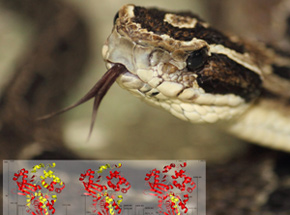Company improves technology through collaborative research with universities
By supporting to projects conducted at universities, Agilent has been able to develop solutions and find new applications for its products.
Company improves technology through collaborative research with universities
By supporting to projects conducted at universities, Agilent has been able to develop solutions and find new applications for its products.

By supporting to projects conducted at universities, Agilent has been able to develop solutions and find new applications for its products
By Elton Alisson
Agência FAPESP – In oceans, lakes, reservoirs and rivers, a natural phenomenon causing the water to turn darkened hues of green, red (red tide), brown, orange or yellow is common. Caused by the excess growth of microscopic algae or cyanobacteria found in marine and fresh water plankton, the phenomenon is known as “algae or cyanobacteria blooms.”
The main problem this phenomenon causes is that some species of cyanobacteria and marine microalgae that cause it are capable of producing potent toxins. In fresh water, for example, some of the species that participate in cyanobacteria flowing can produce toxins (microcystin), which are highly prejudicial to human health, in addition to volatile organic compounds (VOCs), which are resistant to conventional water treatment. As a result, they cause a strong odor and alter the taste of water. In a marine environment, some toxins produced in blooms can accumulate in fish and seafood.
A group of researchers at the Department of Clinical and Toxicological Analysis at the School of Pharmaceutical Sciences at Universidade de São Paulo (FCF-USP) began a study to look for some of these VOCs capable of causing environmental impacts produced by different cyanobacterial species and strains isolated in the Billings and Guarapiranga reservoirs in São Paulo and the Salto Grande reservoir in upstate São Paulo.
Conducted under the auspices of a cooperation agreement between FAPESP and Agilent Technologies, in addition to contributing to better understand the role played by some of these compounds in the growth of cyanobacteria, the results of the study can aid in the development of more efficient analytical methods to identify and quantify these compounds that can be used, for example, as biomarkers to predict the growth of these bacteria.
“This type of collaborative research project affords access to new scientific problems that can help identify opportunities for applications for our products or to develop new technologies to solve them,” comments Jack Wenstrand, Agilent university relations director.
On December 4, the executive participated in an update meeting at FAPESP’s headquarters on the two research projects selected from a joint call for proposals released in 2011 by the two institutions.
The call had the objective of identifying, selecting and supporting world-class research on advanced instrumentation and measurement techniques for metabolomics in plant biology and microbiology, mass spectrometry and bioenergy.
Besides the project seeking volatile compounds produced by cyanobacteria and with applications in traditional medicine, another approved project focused on the study of the physiological responses of the Eucalyptus globulus and E. grandis eucalyptus species to a high concentration of carbon dioxide and temperature variations, identified by metabolomics. The project has been undertaken by researchers at Universidade Estadual de Campinas’ Biology Institute (IB-Unicamp).
Gains for both sides
According to Wenstrand, the first two collaborative research projects conducted by Agilent in Brazil with researchers from the universities of São Paulo State, through an agreement with FAPESP, are part of their corporate program to support scientific collaboration in research aligned with the company’s strategic objectives.
Through the program, according to Wenstrand, the company conducts diverse research activities in collaboration with scientists from universities from around the world on topics related to electronics, life sciences, chemical analysis and diagnostics.
“These collaborations afford access to innovative research that helps to improve our products and develop technologies to solve the problems that exist today and for which there is no solution, or for those that should emerge in the future and that we are prepared to face,” commented Wenstrand.
In the executive’s opinion, for researchers this type of scientific collaboration makes it possible to have access to or receive training to operate equipment and state of the art technology that help them to approach a given problem on which we have broad knowledge, but that many times do not have or do not know tools that can help them.
In order to conduct the project on the physiological response of two species of eucalyptus to high concentrations of carbon dioxide and temperature variations, for example, Agilent will license three modules of a cutting-edge genetic sequencing analysis software to conduct transcriptomic and metabolomics analysis of Eucalyptus globulus and E. grandis eucalyptus species.
“I discovered this software during the project and became very interested in utilizing three of its four modules, which company quickly licenses,” comments Paulo Mazzafera, professor at IB-Unicamp and coordinator of the project.
According to the researcher, in addition to the three software modules, there is also the possibility of conducting certain types of analysis of applications that the company has in Brazil on equipment that it still does not have.
“This type of interaction between the company and the university can also result in future partnerships,” highlights Mazzafera.








